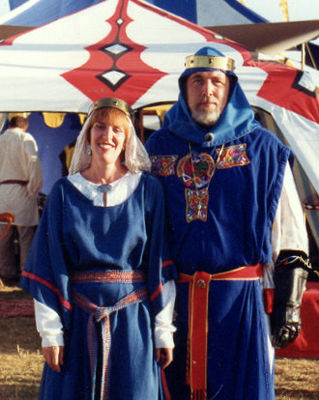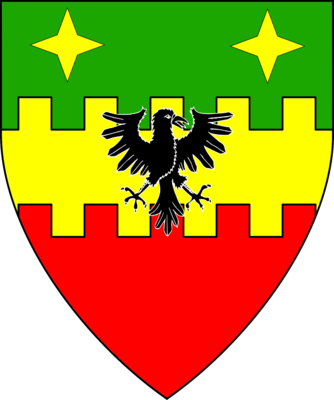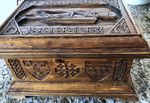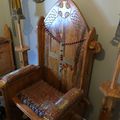Bors of Lothian
| Photo | ||||||||
|---|---|---|---|---|---|---|---|---|
 Baron Bors of Lothian and Baroness Anne of Ayr, Pennsic War, 1992 | ||||||||
| Information | ||||||||
| ||||||||
| Order of Precedence | ||||||||
| ||||||||
| Heraldry | ||||||||
 Per fess vert and gules, on a fess embattled counter-embattled Or, a raven displayed and sinister facing sable, in chief two mullets of four points Or. |
His Excellency, Baron Bors of Lothian
Previously Known As:
Nickname(s):
Pronouns:
Additional Registered Heraldry:
Offices:
- Local Offices Held
- Prior Knight Marshal of Loch Soilleir
- Prior Founding Baron of Loch Soilleir


Persona History:
In the year of our Lord 1288, in the castle of McAndrews, outside the village of Polmont, west of Edinburgh and within sight of the Antonine Wall, in the kingdom of Lothian, was born to the Laird of the castle and his Lady, a second son. Since the Lady of the Laird was a devotee of the Arthurian legend, she named her first born Balin and her second son Bors. Her husband was not present at the birth of his new son, as he was in the Holy Land defending the city of Acre, in the name of the Lord, from the heathen infidels of Al Ashraf.
On 18 May, in the year of our Lord 1290, a great sorrow fell upon the people of Polmont, for on this day the city of Acre was completely destroyed by the Moslem hordes. With the fall of the city so ended the life of the Laird of McAndrews. It took several months for the news to reach the castle, but plans for the installation of a new Laird were already in place. Lord Balin of Lothian, upon the news of the death of his father, assumed the title of Laird of the castle. Since Alexander Ill's death in 1284, the kingdom was held by the minority of Margaret, the Maid of Norway, the only surviving heir to the throne of Scotland. Emissaries were sent to her in Norway to obtain confirmation of this appointment and returned with great tidings. Because of the great valor of the old Laird McAndrews at the fall of Acre, the Maid conferred upon the new Laird the title of Baron and awarded him lands and titles in perpetuity.
Since I was the second son and could not hold title to the family land as long as my older brother ruled, I was destined for the life of the religious orders. In the year of our Lord 1301, at the age of thirteen, I joined the Order of the Temple of Solomon as a lay brother and began my life in the religious order. Although I belonged to the Edinburgh Temple, it was not long before I began my journeys in life. In the year of our Lord 1302, I was transferred to the island of Cyprus to help defend the Temple garrison. After almost three years in Cyprus, I was again moved. This time my travels took me to the Temple in Paris. Here I worked, learned and continued my training until a fateful day in history.
In the early morning of 13 October, 1307, two Knights of the Temple burst into my cell in the monastery and called for me to immediately dress and follow them. Bewildered and confused, I still obeyed instantly. The two knights then led me down a secret corridor that ended at the river Seine. Here at the water's edge, several ships were waiting, loaded with a covered cargo and many of my friends. We were soon joined by many other Templar knights, most of them unknown to me. Ordered in a whisper to man an oar, we quietly followed the river to the town of La Rochelle. Once we made the port of La Rochelle we transferred all of our cargo onto the Temple fleet based there and with all haste, left France forever. On that fateful day in history, Friday the 13th, 1307, a day that shall be considered an unlucky one for the rest of history, the Order of the Temple of Solomon was betrayed by their King and their Pope. For on this day Phillip IV of France began his suppression of the Templars. If we had not been forewarned, I probably would have been burnt at the stake as so many of my fellow Templars were.
After several days at sea one of the Templar knights took me aside and questioned me for several hours. He asked questions about my home and the political climate in Scotland, and the availability of deep water ports in the area where I lived as a child. It then dawned on me that I was going home, back to Scotland. We did not land at the Firth of Forth near Edinburgh as I had thought we would, for the English navy based at Berwick controlled the seas in the channel, so we took a longer and safer route around England and entered Scotland on the west coast. We landed at the port of Kilmory, a fair village guarded by the Castle Sween. The man who controlled this castle was called Angus Og MacDonald, and he was my mother's brother. My uncle welcomed all of us with open arms. I was home.
We spent a pleasant winter at Kilmory, planning what action should be taken next. Many of the brothers wished to begin building a new Order of the Temple in Scotland with the approval of the new Scottish King, Robert I, called the Bruce. Others wished to return to France and make a defense for the Order; still others did not know what they wanted to do. Soon it would all be decided for us.
In the winter of 1307, Edward the First died at Burge-upon-the-Sands in Cumberland. The "Hammer of the Scots" had struck his last blow against my homeland.
In the spring of 1308, The Bruce visited Kilmory and stayed for over two months. When he left for Edinburgh, he took with him over two hundred Templar knights and men at arms. Fortunately, I was asked to accompany the group. For the next six years, the Templars secretly fought for the Bruce, foregoing the traditional Templar garb and slowly being assimilated into Scottish society. From that alliance, the fortunes of Robert the Bruce slowly improved. He slowly began to take back all of the castles that he had lost to the English. During this time, I had many opportunities to visit my home in Polmont and become reacquainted with my brother and mother. It was during one of these visits that a villager ran to the castle to report that a large English army was less than a day away, and was heading for Stirling Castle, located only ten miles away from our home.
Wishing to confirm this report, my brother and I raced to intercept the English army and determine the size and disposition. My brother also sent a trusted messenger to the Bruce to inform him of what he had learned. We reached the English at about dusk, and were easily able to observe
them without them seeing us. From our vantage point, we estimated the army to be approximately 500 knights and 8000 foot soldiers, and moving very slowly.
We decided to make haste back to Edinburgh as quick as we could. Once in Edinburgh, my brother was ushered quickly into the presence of the Bruce. It didn't take him long to convince the Bruce of the seriousness of the situation. When he came out of his meeting with the Bruce, he told me to ride to Kilmory and return with all speed with the remaining Templars left there, and any other parts of the Scottish army I could readily assemble. Riding at breakneck speed throughout the night, I reached Kilmory the next morning and called for all of the fighters to hasten to Stirling Castle and there join up with the Army of the Bruce. I was informed that the new Grand Master of the Temple was lodged at a Castle just to the south of Kilmory near a town named Ayr. Wishing to gather as many men as possible in as short a time as I could, I jumped once more into the saddle and raced to Ayr. After reaching the Castle of Ayr, I was admitted into the presence of the Castellan and the new Grand Master of the Temple. I hurriedly informed them of the gathering at Stirling Castle. They assembled all of the fighting men in the castle and ordered them to make ready with all speed. While preparations were underway, the Grand Master ordered me to get something to eat and rest during his preparation. The Castellan asked me to sit in his great hall, and said he would have his daughter bring me something to eat. After two days in the saddle and with very little to eat, it would be a welcome repast.
Sitting in the great hall, I was soon brought a marvelous feast by the most beautiful woman I had ever seen. She saw to my comfort for those few minutes while I ate, and then she was gone. She politely excused herself so she could help her father make his preparations. I learned from one of her ladies-in-waiting that her name was Anne, and that she was unmarried. I knew that I had to leave very shortly, but I made a silent vow that I would truly be back to this castle and to this Lady.
We left the castle at dusk. At our head rode the Grand Master, and behind him was gathered almost 200 knights, squires and men at arms, each and every one riding a horse and wearing armor and carrying a sword. Midway to Stirling, we were joined by other knights and men at arms from Kilmory. Altogether we now numbered almost 7OO knights and men at arms. Someone handed me a white Templar tunic with the red splayed cross and told me to wear it into the upcoming battle. It had been almost seven years since I last wore the Templar tunic, and it gave me a thrill to put it back on.
We made the vicinity of Stirling Castle on June 24, 1314, and discovered that the Bruce and the Scottish army had engaged the English at a small stream called the Bannock. In Gaelic it was called Bannockburn. As we came over the rise into view of the battle, we could tell that the vastly outnumbered Scots were holding their own due to the Bruce's brilliant use of the Scottish spearmen. We quickly discerned that the flank of the English was vulnerable and so we hit them at full charge.
In only a few minutes the entire English army was put to flight. We chased the remains of the English army all the way to Berwick, taking many prisoners and much booty along the way. But all the riches in the world couldn't replace my brother, who perished in one of the charges of the English cavalry on the previous day. I was now the Baron and the head of the family Clan.
After the battle of Bannockburn, we buried my brother and the other brave men who fell that day. Immediately after the funeral services, I was invested as the new Baron and ordered by the Bruce to return to the family castle and secure the area, as there were still many English stragglers in the vicinity. This I did and followed all other orders of the King. My days in the Temple were over, and my life as a Baron began.
One year later, on a warm day in June, I returned to the Castle of Ayr, and won the heart of the Lady Anne as I had vowed I would. We were married with the blessing of her father and mother in the fall of the year of our Lord 1315. She was invested as Baroness and we took up residence in the Castle McAndrews, where we now reside.
In the year of our Lord 1329, 7 June, the Bruce passed away to his heavenly reward. His one wish was to have his heart buried in the Holy Land. So, in keeping with his wish, the Douglas recruited several Barons and knights to accompany him and the Bruce's heart to the Holy Land for Interment. I volunteered to accompany the Douglas, as it was always my desire to make pilgrimage to the Holy Land. We landed in Spain in the year of our Lord 1330. Due to a severe bout of dysentery, I was forced to remain on the coast with several of my companions who suffered the same illness. We were left behind so as the others could make haste, because a large Moslem force was reported near the interior of Spain, which we wished to avoid. After we recovered our strength, we made good time to catch up with the rest of the company, but we found our friends too late. A force of 4000 Moslems had caught up to them and engaged them in battle. Although Douglas' men were outnumbered 20 to 1, it was reported that before the slaughter that ensued, the Douglas threw the heart of the Bruce into the middle of the Moslem horde and then rushed in after it, knowing that it was to his death. When I found my friends on the battlefield, they were all dead. I retrieved the Bruce's heart and the bodies of the other nobles and returned to Scotland. Sadness filled my heart over the loss of our good companions, and for the knowledge that I would never see the Holy Land.
In the year of our Lord 1349, we were blessed with our first born son, Nicholas. He survived infancy and now grows in strength and stature daily. One day he will make a fine warrior.
It is now the year of our Lord 1353, and I am 65 years old. Most of my friends and family are now dead. My dear wife and I are still Baron and Baroness. My only desire now is to ride a good horse in the hunt, nap in the warmth of the afternoon sun and enjoy the glow of a good evening fire, my wife at my side and my favorite dog at my feet.
Life has been good to me.
Interests:
Everything.
Gallery:
- Arts & Sciences projects
-
The glass windows are my attempt at replicating the windows in St Margaret’s chapel (the world's smallest royal chapel ) at the castle in Edinburgh
-
The wood carvings are my design based on a medieval design book
-
Sword bought at Pennsic, scabbard is my own work.
-
I make all my own scabbards!
-
Made in 2017, with a matching pre deuis (prayer kneeler) for a Loch A&S competition.
Timeline of Activity:
Prior Groups:
Populace Provided Information:
Notable Contributions or Accomplishments:
- Three time winner of the Tournament of the Nine Worthies.
Non-Armigerous Awards and Recognitions:
Affiliations:
- Married to Anne of Ayr
- Squired to Rurik Ivarrson
Mundane Information:
Retired professional photographer and retired History teacher.
Special Needs:
In Case of Court:






